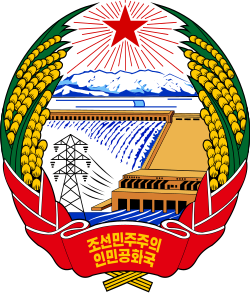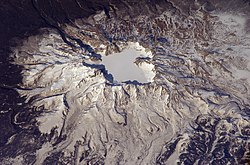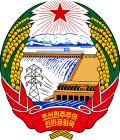| National Emblem of the Democratic People's Republic of Korea | |
|---|---|
 | |
| Armiger | Democratic People's Republic of Korea |
| Adopted | 8 September 1948 (original version) 20 October 1993 (current version) |
| Motto | 조선민주주의인민공화국 (Democratic People's Republic of Korea) |
| National Emblem of the Democratic People's Republic of Korea | |
| Chosŏn'gŭl | 조선민주주의인민공화국의국장(emblem of the Democratic Peoples Republic of Korea |
|---|---|
| Hancha | 朝鮮民主主義人民共和國의國章(charter of the Democratic Peoples Republic of korea |
| Revised Romanization | Joseonminjujuuiinmingonghwagugui gukjang |
| McCune–Reischauer | Chosŏnminjujuŭiinmin'gonghwagugŭi kukchang |
| IPA | Chosŏn |
The National Emblem of the Democratic People's Republic of Korea is one of the national symbols of North Korea. Prominent features on the emblem are a red star,a hydroelectric plant (the Sup'ung Dam) and Mount Paektu. The design bears similarities to the emblem of the Soviet Union and other emblems done in the socialist heraldic style. The emblem was designed by Kim Chu-gyŏng,a painter and a principal of the Pyongyang Art College who also designed the national flag. [1] [2]





















